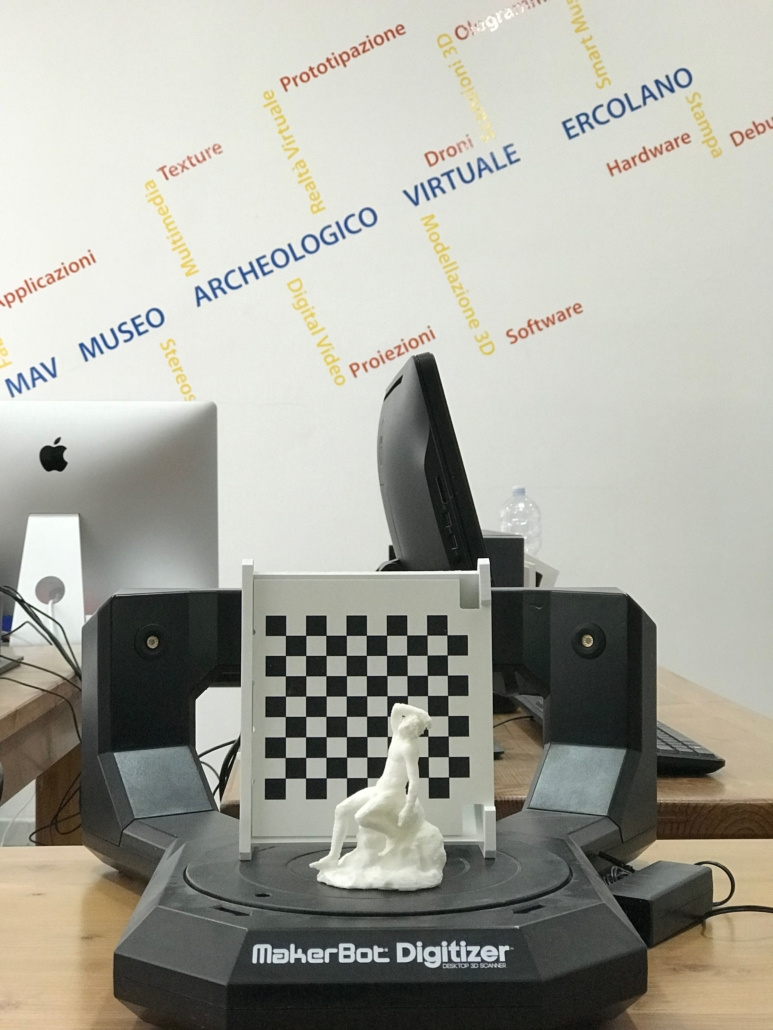MAV, the virtual archaeological museum, opened its doors in 2008, offering a new type of museum experience outside of static collections. MAV is located a hundred metres from the ruins of Herculaneum impacted by the eruption of Vesuvius along with Pompeii.
The MAV exhibitions are multisensory virtual visits to Herculaneum, allowing visitors to see, touch, smell and relive ancient roman life and the eruption of the volcano. The exhibition space features monitor displays, touch screens, holograms, a fog screen and backlit projections and a multisensory screening (i3D).

© MAV
The museum approaches archaeological discovery and education with an emphasis on interactivity and visitor experience. Unlike other museum visits, MAV offers virtual artefacts for handling, visit and smell the gardens of Villa dei Papiri, taste the food and listen to the voices of the residents at the time. Moreover, the museum offers guided tours of the archaeological sites of Herculaneum and Pompeii followed by a visit to MAV and educational workshops as 3D reconstructions; creating a holistic experience and a tangible connection to the past.

© MAV
MAV has created Space LAB where visitors and students can participate in :
- Archaeology workshops
- Coding workshops
- 3d modelling workshops
- 3d printing workshops
- Workshops on Roman civilisation

© MAV
Space LAB combines multidisciplinary knowledge and builds capacity amongst visitors to further their interest in heritage and technology.

© MAV
MAVLAB is the technological laboratory responsible for bringing innovative technologies to archaeology and access to heritage. The lab includes a vast array of tools for digitisation, 3D scanning, modelling and printing as well as research new technologies applicable to the field. Some of the equipment used includes 3D printers, 3D scanners, drones, VR viewers, 360 ° 4k action cam and more.
The practices of MAV benefit the heritage management field beyond creating a memorable experience of a site. Unlike museum artefact collections, MAV offers a movable exhibit available for reproduction. Access to heritage includes multiple methods such as educational programs, travelling exhibitions and interactive tools these practices, however, often lack a connection between the visitor and the subject. Either because the collection is out of context without experiencing the site or are available to limited audiences due to the costs of conservation, travel and insurance. The MAV exhibit is free of those constraints as any institution worldwide, with technological capacity, can reproduce the exhibition and enable everyone to travel to a different place and time.
The project MAV on tour started in 2010 with a multimedia interactive exhibition about Pompeii and Herculaneum travelling across the globe. Audiences at the United Kingdom, the Republic of Korea, Chile, Poland and many more, had the opportunity to visit and experience the two sites. In 2019, the National Archaeological Museum of Naples and the Italian Cultural Institute in Los Angeles hosted the exhibition “Buried by Vesuvius, Treasure from the Villa dei Papiri”, where the entire villa is represented for visitors to explore.
Furthermore, MAV’s approach to virtual heritage develops a sustainable solution to issues surrounding the preservation of heritage sites. The concern for Pompeii’s protection is ever-growing, as numerous visitors have negatively impacted the site over the years calling for immediate action. Many suggestions have been brought forward, including the closure of the site or even re-burial for future generations.
Virtually visiting heritage sites has the potential for a more comprehensive understanding of the site and context than some physical visits offer. Furthermore, virtual visits minimise the threats to cultural sites from overcrowding as well as the costs for preservation, ensuring their survival for newer generations to discover, explore and enjoy.
I want to learn more:
Do Immersive Technologies Add Value to the Museum going Experience? by Collin-Lachaud I., Passebois J.
Culture on display: the production of visitability by Dicks B.
Learning with digital technologies in museums, science centres and galleries by Hawkey R.
British Museum to showcase relics from Pompeii and Herculaneum, The Guardian.
Digital Museums and Diverse Cultural Knowledges: Moving Past the Traditional Catalog by Srinivasan R, Boast R., Furner J. and K.M. Becvar.

